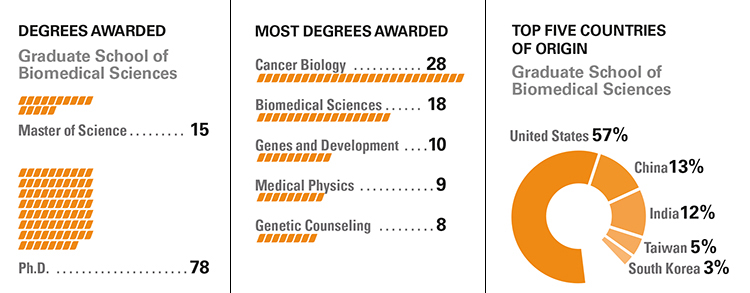Graduating to big things before returning to MD Anderson
When Joya Chandra, Ph.D., joined the faculty of MD Anderson’s pediatrics department in 2002, she felt an immediate kinship with the researchers, clinicians and, especially, with the students.

That’s because Chandra herself spent four years as a student at The University of Texas Health Science Center (UTHealth) Graduate School of Biomedical Sciences, located on the MD Anderson campus.
Nestled in the heart of the Texas Medical Center and located in MD Anderson’s George and Cynthia Mitchell Basic Sciences Research Building, the school is run by two institutions — MD Anderson and UTHealth. This unique partnership unites 580 faculty members from both institutions to teach students who conduct biomedical laboratory research. Two deans — one from each institution — work together to lead the school.
“I trained with some of the best scientists in the country,” says Chandra, who graduated in 1998 with a Ph.D. in cancer biology and immunology.
After earning her Ph.D., Chandra, like many GSBS graduates, became a postdoc — a Ph.D. recipient who continues learning by conducting research in a mentor’s lab, typically for two to five years. This stint, called a postdoctoral fellowship, is frequently required to obtain tenure-track faculty positions, especially at research-oriented institutions.
Chandra completed not one, but two postdoctoral fellowships — the first at the Karolinska Institute in Sweden and the second at the Mayo Clinic. When she finished, she returned to Houston and joined the MD Anderson faculty.
“As a graduate student I was impressed by the culture of collaboration between clinicians and researchers,” says Chandra. “MD Anderson was at the top of my list when I was deciding where to begin my independent career as a translational researcher (a scientist whose laboratory findings will be translated into medical therapies for patients).”
Fourteen years later, Chandra is an associate professor at the Children’s Cancer Hospital where she studies how unstable molecules known as free radicals lead to cancer progression, resistance to chemotherapy and tissue damage. She encourages children with cancer to eat healthy foods that contain antioxidants — molecules that prevent free radicals from harming healthy tissue. In addition to her research, Chandra and colleagues created an online cookbook (mdanderson.org/ recipes) filled with recipes taste-tested and approved by pediatric cancer patients and their families.


Patrick Dougherty, Ph.D.
Professor of Anesthesia and Pain Medicine
Education: Ph.D. in Biomedical Science, Graduate School of Biomedical Sciences, 1988
Why I joined MD Anderson: MD Anderson and the nearby institutions in the Texas Medical Center provide an outstanding biomedical science environment that fosters high-impact translational science unlike anywhere in the world. And Houston is a great place to live. It has all the amenities of a big city, but small, affordable neighborhoods in excellent school districts.
Key research: My research seeks a better understanding of the biologic mechanisms that cause peripheral nerve damage in patients undergoing chemotherapy. This research could allow current chemotherapies to be given in higher, more effective doses, and could help in the development of new chemotherapies with less severe, pain-related side effects.

Ralf Krahe, Ph.D.
Professor of Genetics
Education: Ph.D. in Genetics, Graduate School of Biomedical Sciences, 1995
Why I joined MD Anderson: As a Graduate School of Biomedical Sciences alumnus, my decision to join the MD Anderson faculty was easy. I joined because of the exceptional research opportunities and environment, and outstanding colleagues in the Department of Genetics. My decision was facilitated by the unique institutional culture and the wonderful educational opportunities at the graduate school, which allow me to combine my passions for genetics research and education at my alma mater.
Key research: I identify and characterize disease genes and their mutations and variants, and am particularly focused on inherited cancers such as Li-Fraumeni syndrome, a rare disorder that leads to a higher risk of developing certain cancers at a younger-than-average age.

Peng Huang, M.D., Ph.D.
Professor of Translational Molecular Pathology
Education: Ph.D. in Pharmacology, Graduate School of Biomedical Sciences, 1990 (M.D., Zhongshan Medical College, Guangzhou, China, 1982)
Why I joined MD Anderson: Nothing compares to MD Anderson. The close interaction between scientists in the lab and patient-care professionals in the clinic provides a seamless pathway for translating laboratory findings into medicines and therapies for patients.
Key research: I’m investigating differences between leukemia cells and normal cells, which is research that provides a biochemical basis for the design of new drugs and strategies that will selectively kill cancer cells.

Dihua Yu, M.D., Ph.D.
Professor and deputy chair of Molecular and Cellular Oncology
Education: Ph.D. in Molecular and Cancer Biology, Graduate School of Biomedical Sciences, 1991
Why I joined MD Anderson: At MD Anderson, I’m privileged to work side by side with world-class biomedical scientists and physician-scientists. By pooling our knowledge, we’ve fast-tracked our laboratory research findings to clinical trials that are continually leading to new diagnostics and therapeutics to save cancer patients’ lives.
Key research: My laboratory research focuses on how and why cancer begins, spreads and resists various treatments, with an emphasis on breast cancer.

















